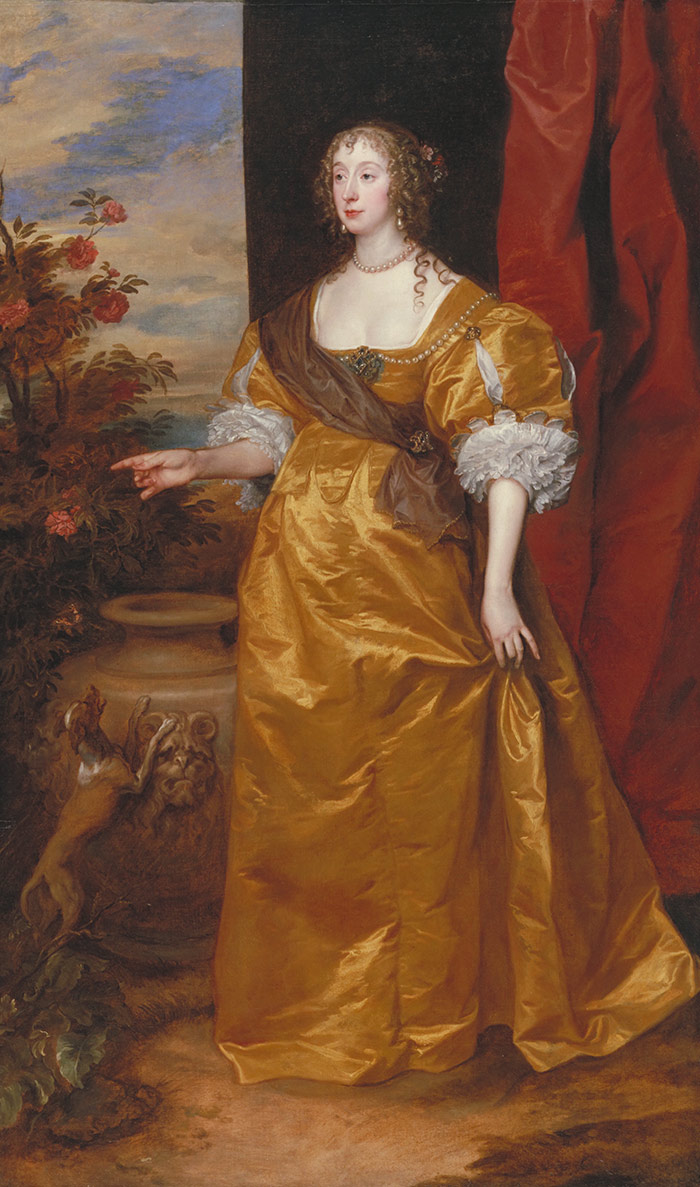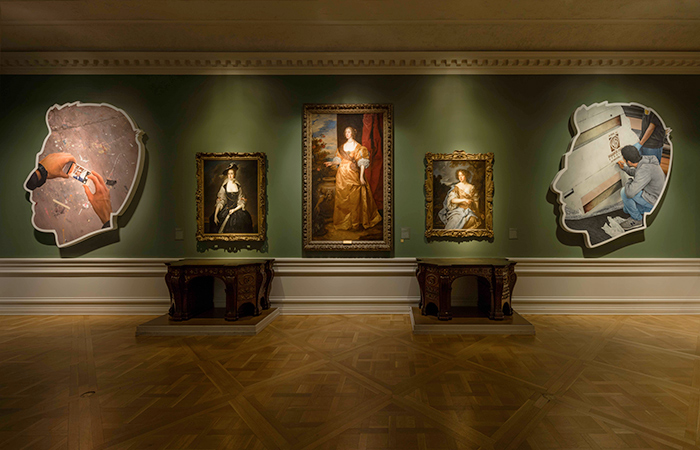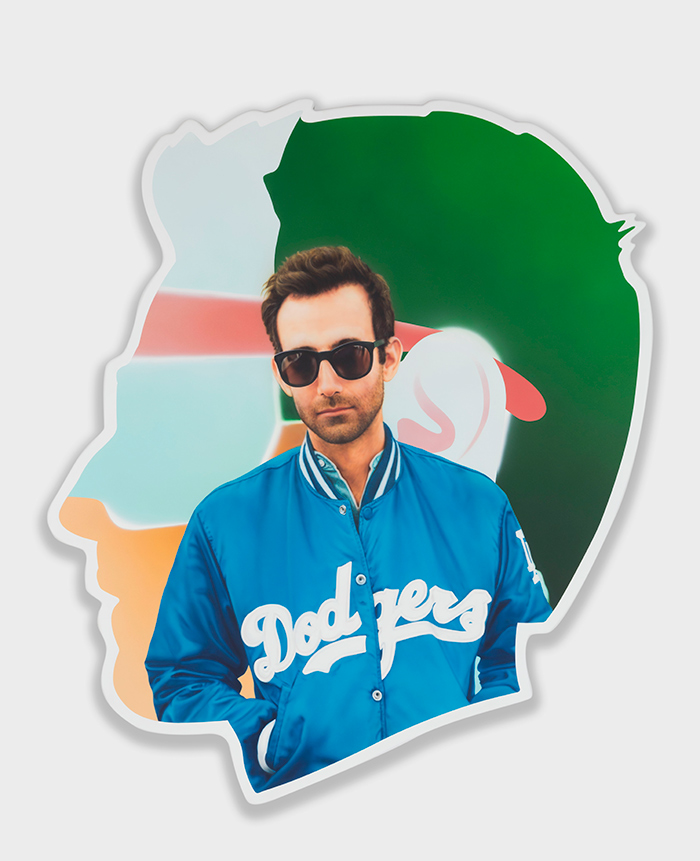The Huntington’s blog takes you behind the scenes for a scholarly view of the collections.
Evolution of a Van Dyck
Posted on Wed., March 2, 2016 by

Anthony van Dyck's Anne (Killigrew) Kirke came to The Huntington in 1983, thanks to a generous bequest by local collectors. The Huntington Library, Art Collections, and Botanical Gardens.
A major U.S. exhibition on Flemish master portrait artist Anthony van Dyck (1599–1641) opens today at New York’s Frick Collection. The Huntington has its own van Dyck story to tell. At its center is the artist’s beautiful full-length painting Anne (Killigrew) Kirke (ca. 1637), showing its subject lavishly attired in a dazzling shimmer of golden-brown silk, with a swath of brown gauze across her torso and iridescent pearls that reflect the burnished highlights of her dress.
Van Dyck’s attention to fashion wasn’t mere window dressing. The painting commemorated Kirke’s appointment as dresser to Queen Henrietta Maria—a position demanding a sophisticated knowledge of protocol and fashion. In the painting, Kirke points to a leaping dog, a butterfly, and a flowering rosebush—symbols of fidelity, willingness to serve, and pain endured for pleasure—references to her marriage (to George Kirke, gentleman of the robes to King Charles I) and her patience in her role at court.

The Thornton Portrait Gallery contains a blockbuster display of British grand manner portraits collected by Henry and Arabella Huntington. The Huntington Library, Art Collections, and Botanical Gardens.
At the time, van Dyck was considered the leading court painter in England. His lush and elegant full-length depictions of nobility revolutionized British art and influenced later painters, including Peter Lely, Thomas Gainsborough, and Joshua Reynolds—all of whom are represented in The Huntington’s collections. Henry Huntington recognized van Dyck’s works as the artistic ancestors to the grand manner paintings that he and his wife, Arabella, had amassed (and which now hang in the Thornton Portrait Gallery). He longed to have a van Dyck of his own.
Alas, possessing a van Dyck remained out of Huntington’s reach during his lifetime. It wasn’t until 50 years after his death that Anne (Killigrew) Kirke arrived at The Huntington, with the help of local collectors Mildred Browning Green and Judge Lucius Peyton Green. Their gift in 1978 of the Adele S. Browning Memorial Collection included a small but important group of 17th- and 18th-century European paintings and decorative arts, as well as a “substantial fund” to support the growth of, and care for, the collection.

Thomas Gainsborough (1727–1788), Blue Boy, 1770, oil on canvas. The Huntington Library, Art Collections, and Botanical Gardens.
Fortuitously, van Dyck’s portrait of Kirke became available shortly afterward, and The Huntington was able to purchase it in 1983. The director of the art collections at the time, Robert Wark, called the painting “the most desirable single acquisition made in the past half century.”
Today, the painting of Kirke hangs on a wall facing the Thornton Portrait Gallery, as if declaring her seniority over her artistic offspring. Inside the hall of grand manner portraits is The Huntington’s best known painting, Blue Boy, in which Gainsborough put into practice many of the elements van Dyck made popular in his portraits of aristocrats. This included showing Blue Boy standing upright, placing him in a natural setting, and positioning the figure so that the viewer is forced to look up at him. It was also no accident that Blue Boy wore knee breeches and a doublet with lace collar—a costume typical of van Dyck’s time, 100 years prior to Gainsborough’s.

From left to right, Alex Israel, Self-Portrait (Selfie and Studio Floor), 2014, acrylic and bondo on fiberglass; Thomas Hudson, Lady Frances (Finch) Courtenay, ca.1741, oil on canvas; Anthony van Dyck, Anne (Killigrew) Kirke, ca. 1637; Peter Lely, Lady Essex Finch, ca. 1675, oil on canvas; Alex Israel, Self-Portrait (Signature), 2014, acrylic and bondo on fiberglass. Photo by Fredrik Nilsen, courtesy of The Huntington.
There’s another progression currently on view in the gallery housing the van Dyck—one that transports us all the way to the present. It’s a contemporary exploration of portraiture by L.A.-based artist Alex Israel (b. 1982). Two works by Israel—Self-Portrait (Selfie and Studio Floor), on the left, and Self-Portrait (Signature), on the right—flank Anne (Killigrew) Kirke and two other portraits, Thomas Hudson’s Lady Frances (Finch) Courtenay, ca.1741, and Peter Lely’s Lady Essex Finch, ca. 1675.
Israel’s work comments on—and complements—the Thornton Portrait Gallery’s showcase of the British noble class. In one of the self-portraits, Israel wears a blue satin L.A. Dodgers’ starter jacket—a nod to Blue Boy’s iconic suit.
Van Dyck revolutionized British painting with his treatment of royalty—England’s celebrities of the day.
Israel is also concerned with celebrity. His unabashed grand manner–sized self-portraits force us to consider questions about portraiture, fame, and fine art—not of the British noble class, but of Hollywood and the cult of a very different sort of celebrity.

Alex Israel, Self Portrait (Dodgers), 2014‒2015, acrylic and bondo on fiberglass. Collection of the artist. Photo by Joshua White.
You can read more about The Huntington’s collection of Old Master paintings, sculpture, and decorative arts in a new book, Blue Boy & Co.: European Art at The Huntington. The catalog, edited by Catherine Hess and Melinda McCurdy, is available at the Huntington Store and contains more than 150 full-color photographs. The exhibition “Alex Israel at The Huntington” is on view through July 11, 2016, in the Huntington Art Gallery.
Related content on Verso:
Alex Israel in the House (Dec. 10, 2015)
Portraiture as Interaction (Dec. 7, 2015)
Diana W. Thompson is senior writer for the office of communications and marketing at The Huntington.